In addition to being a unique technology, mp3 also owes its success to the marketing efforts of the development team that guided mp3 to market success against all odds. The developers never lost the conviction that mp3 would be the future – even at the beginning of the 1990s when success was yet to come and the consumer electronics industry was reluctant to give it a chance.
David vs. Goliath: The marketing of mp3
Fraunhofer IIS started selling professional equipment to radio stations while mp3 was still in development. Previously, stations had to rent expensive dedicated lines to broadcast audio recordings between studios. But thanks to the new equipment from Fraunhofer IIS, stations were now able for the first time to broadcast audio recordings in high quality using the standard ISDN telephone network – saving them money. Fraunhofer IIS, on the other hand, invested the revenue from equipment sales into the ongoing development of mp3.
Once the mp3 standard had been finalized, many of the big consumer electronics companies weren’t interested in the format, either because they didn’t believe that mp3 could be a success, or they had developed their own formats that they wanted to bring to market.
 Fraunhofer Institute for Integrated Circuits IIS
Fraunhofer Institute for Integrated Circuits IIS